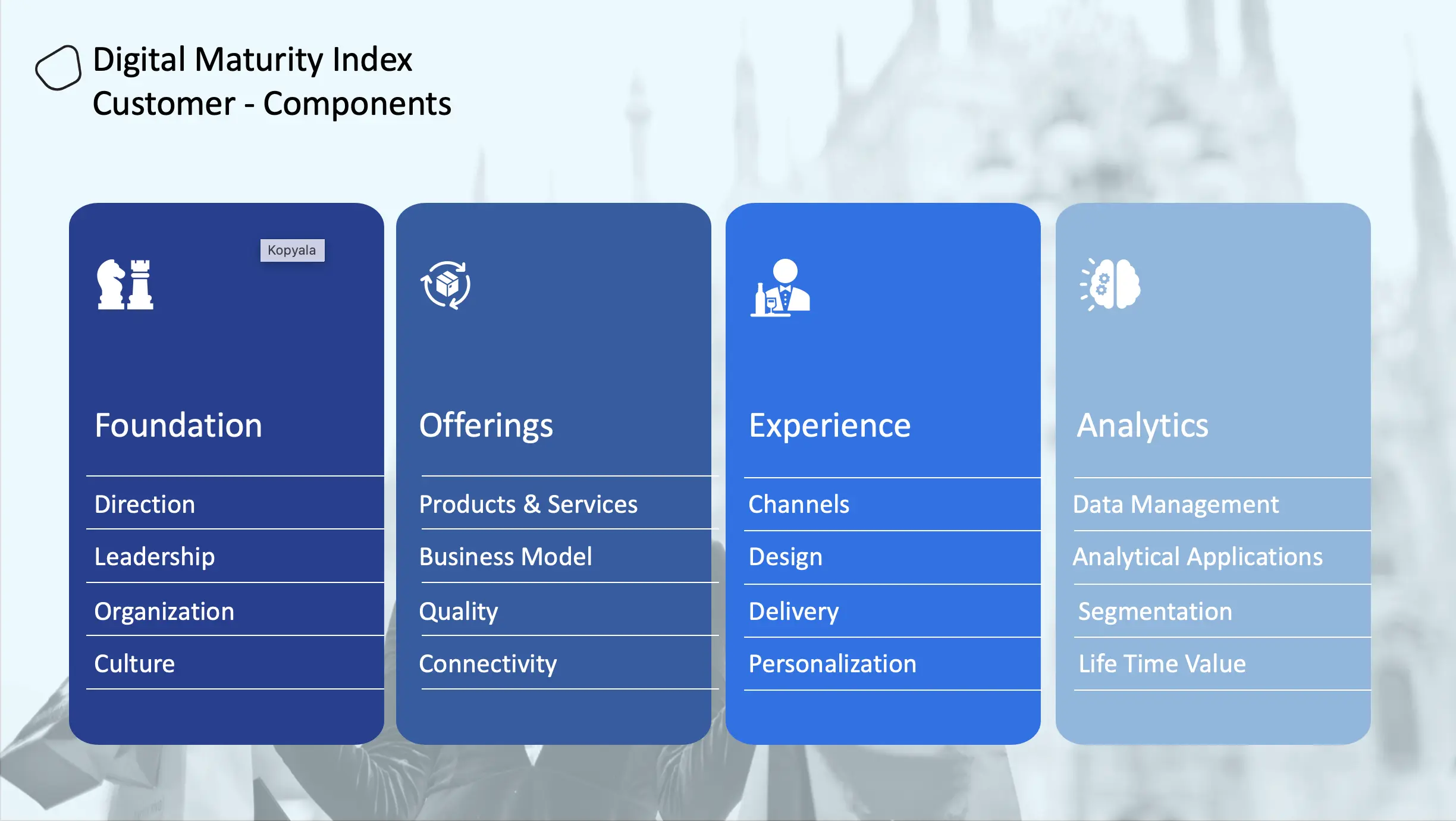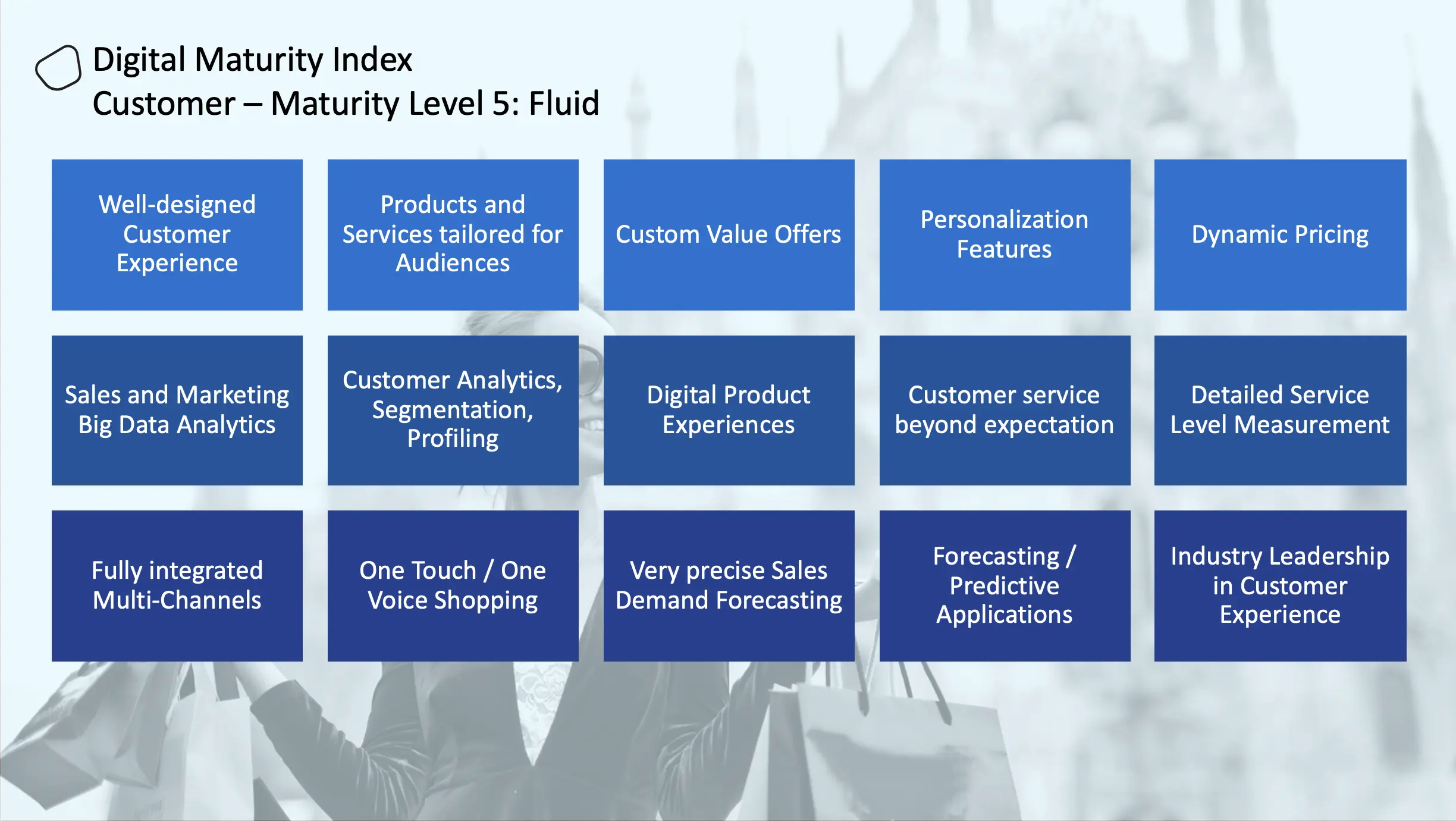
If we must name only the most important reason for digital transformation, it would be “the customer”. The internet and the smartphone empowered the end user as never before. Having a shop on “main street” was a very important strength before the internet. But today, the shop is in the palm of the consumer and there is no main street or high street anymore. Your competitor is just one click away.
Therefore, most of digital transformation programs focus on customers, customer experiences, and customer analytics. The better you know your customer, most probably, the better you can serve her. The right product, at the right time, at the right place, the right promotion or the right price, now, is just a matter of algorithms and calculated in microseconds. This is true for the internet giants, in the West or in the East. Are you capable of doing the same?
As one can see, focusing on the customer is truly essential. Therefore, we put the customer dimension at the very first place in our digital maturity index. The more you digitalise the customer, the relations, the transactions, the interactions, the usage of the products and services, the better you can analyse and understand who the customer is, why she is doing what she is doing, and probably even predict what she is going to do next.

To achieve “customer excellence” an organization must succeed in many components. We structured them in four main groups: The foundation, the offerings, the experience, and analytics. All of them are equally important, all of them are tightly integrated, and all of them must improve and mature simultaneously.
The foundation are the strategic capabilities, the direction of the “customer excellence program”, having leadership in place, being organised and having the necessary skills available, and establishing a customer-centric culture in the organisation.
The offerings are everything you offer your customers. Your products, your services, your promotions, your business models, your value propositions. Digital transformation means to be able to digitally connect these offerings with the customer and make meaningful interactions possible. These generate tons of data, which again help to improve product and service quality, and eventually to improve overall customer value.
The experience is what the customer lives through while consuming your services or products, using your channels or engaging with your brand in general. This is very emotional, sometimes delighting, sometimes frustrating, not only depending on your performance, but also very much related to the perceived quality, timeliness and value on the consumer end. Not always easy to satisfy a customer in a difficult situation.
Analytics is probably the most important dimension in terms of knowing your customer and improving the overall value for both ends. The offerings and experiences will get more relevant to the customer. And respectively the value gained by the company will grow over time, in revenues, loyalty and life-time value, which are all measurable, improvable and specific areas of analytical applications.
On 17th September 2020 we discussed the customer dimension of our Digital Maturity Index together with Mark Walker-Smith, Head of EMEA at Digitopia, Oliver Sheerin, Customer Intelligence Advisor at SAS, and Halil Aksu, Managing Partner at Digitopia.
The importance of continuous measurement was an important outcome. We listened to very exciting examples from SAS how they helped their clients to excel in customer analytics and gain true value out of it.
Digitopia provided strong evidence concerning digital maturity, the impact on digital transformation journeys, and how companies competing on all fronts to get the customers attention. During the webinar Amazon’s strength were discussed and the new business model of subscriptions were elaborated on, with a very recent announcement from Pret-a-Manger’s new offering, a flat fee per month for unlimited beverages. It will be very interesting to watch how those business will evolve.
Our digital maturity index measures on a scale from 1.0 to 5.0. The first maturity level means very basic customer interactions, so we called it “working”. Going up to the highest level, which we called “fascinating”, which describes a state-of-the-art overall customer experience, enabled, augmented and enriched with digital capabilities.
The studies we did in the recent past show that the “customer” dimension is not among the strongest areas of many companies. The overall average of digital maturity was measured 2.7 and the customer dimension average scored 2.6. There is a lot of room for improvement. For sure we will see huge investments in this area in the upcoming times.
During our work with clients we also found out that improving the digital maturity in the customers dimension is particularly difficult. It requires a holistic approach, strong leadership, and synchronized initiatives ranging from design to processes, from applications to culture, and from analytics to quality. Of course, all initiatives rendered worthless, if the processes, the culture, the channels, the products and services are not executed correctly in daily life.
Brief descriptions of each level can be found in the graphic below:

To give you a glimpse into a “fascinating” digital maturity level of the customer dimension, please review the illustration below. It is a brief list of some capabilities a really advanced organisation must have to become a “love mark”.
One of the most customer-centric organisation on the planet is Amazon. At least, that’s their claim. But for sure, at Amazon that’s a corporate culture and the most prioritized strategy. In their offices in every meeting, one chair is left empty, representing the voice of the customer.
Imagine Amazon Prime, the world leading subscription service, having more than 200 million subscribers as of 2022. Imagine Amazon recommendations engine, generated more than a third of their e-commerce revenues.
Not enough, Amazon also put the Echo device in our homes, so we can talk to Amazon all the time and order stuff around the clock. Millions of households are now close friends with Alexa, she is considered like a family member. Could you ever get closer to your customer?

Based on all our experiences and the best practices we have examined, we described the most advanced customer experience, the most fascinating digital maturity in the customer dimension, one can imagine, as of today.
What stands out is the amount, quality and usage of data and turning it into intelligence and insight. The better you know your customer, the better you can serve them. That’s beneficial for the customer and in most cases, it is also very lucrative for the organization. Pricing, campaigns, cost of marketing, service quality, personalized offers and / or experiences, are much better processed and executed on digital channels with rich data sets.
Currently, we use web sites and mobile apps as the go-to channels. But slowly smart watches, voice assistants, other kind of smart devices are picking up and becoming mainstream. For sure there will be other channels customers may want to reach you. So, it’s not just about the number of channels available, it is the overall experience, the integration, the look-n-feel of those channels, and how they contribute value to the user and to the organization.
Imagine a regular store selling a music CD, compared to Spotify, providing you all the world’s music at your fingertips. Guess who collects more information. Guess who knows the customer better. Guess who can turn that knowledge into real loyalty and real revenues. Yes, the answer is obvious. So, there is no other way moving forward than collecting as much as possible information about the customer and turning it into value for all participants. That’s the essence of digital maturity, and that’s the most crucial success factor for your digital transformation.
Check out the rest of the articles in our Digital Maturity Explained series and learn more about all the dimensions of Digitopia’s Digital Maturity Index.
Digital Maturity Explained: All About Business Performance
Digital Maturity Explained: Governance, Reimagined
Digital Maturity Explained: Operations, Rebooted
Digital Maturity Explained: Technology, Reset
Digital Maturity Explained: Innovation, Reignited

